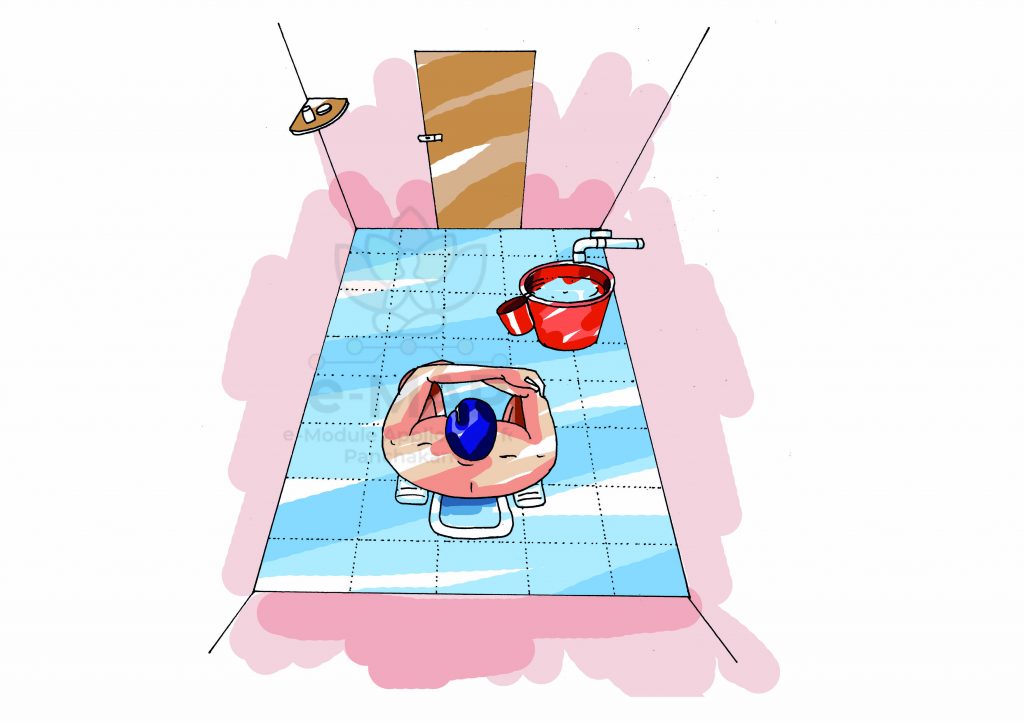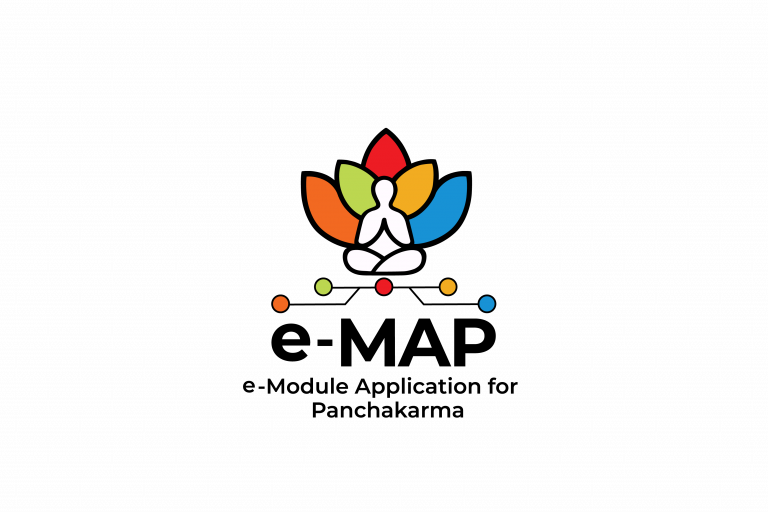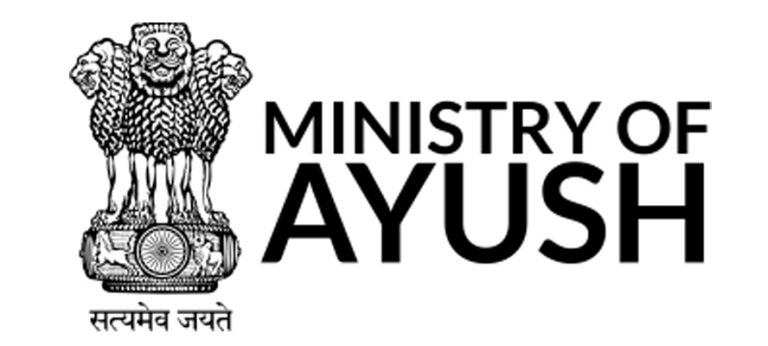
UG Module 5 - Lesson 8
VIRECHANA KARMA

EXPLANATORY NOTES
आध्मानं परिकर्तिश्च स्रावो हृद्गात्रयोर्ग्रहः|
जीवादानं सविभ्रंशः स्तम्भः सोपद्रवः क्लमः||
अयोगादतियोगाच्च दशैता व्यापदो मताः|
प्रेष्यभैषज्यवैद्यानां वैगुण्यादातुरस्य च|| (Cha. Si. 6/29-30)
The ten cardinal complications arising out of improper administration of emesis and purgation are ādhmāna (distension of abdomen), parikartikā (fissure in ano), srāva (excess discharge), hṛt graha (congestion in cardiac region), gātra graha (body stiffness), jīvadāna (bleeding during vomiting), vibhraṃśa (rectal prolapse), sthambha (body stiffness), upadrava (complications), klama (fatigue without excertion).
The above complications arise out of either under activity or excessive activity of the drug because of Preṣya-vaiguṇya (incompetency of the attendant), Bhaiṣajya-vaiguṇya (incompetency of drug),Vaidya-vaiguṇya (incompetency of physician), Ātura-vaiguṇya (incompetency of the patient).
वैद्यातुरनिमित्तं वमनं विरेचनं च पञ्चदशधा व्यापद्यते |
तत्र वमनस्याधो गतिरूर्ध्वं विरेचनस्येति पृथक्; सामान्यमुभयोः– सावशेषौषधत्वं, जीर्णौषधत्वं, हीनदोषापहृतत्वं, वातशूलम्, अयोगो, अतियोगो, जीवादानम्, आध्मानं, परिकर्तिका, परिस्रावः, प्रवाहिका, हृदयोपसरणं, विबन्ध, अङ्गप्रग्रह इति || (Su. Chi. 34/4)
Fifteen different kinds of vyāpat may result from an injudicious use of emetics and purgatives owing to the ignorance of the physician or of the patient. Of these fifteen, the upward coursing in cases of purgatives and the downward coursing in cases of emetics are peculiar to each of them respectively. The fourteen other remaining vyāpat are common to both. They are Sāvaśeṣa auṣadhatva (continuance of the drug in the stomach), Jīrṇa auṣadhatva (complete digestion of the medicine), Hīna doṣa apahṛtatva (insufficient elimination of the Doṣas from the system), Adhika-doṣaipahritatva (excessive elimination of the Doṣas from the system), Vāta śūla (pain due to vāta), Ayoga (insufficient dosage), Atiyoga (over dosage), Jīvādāna (vomiting blood), Ādhmāna (distention of abdomen), Parikartikā (cutting pain in the anus.), Parisrāva (oozing out of stools), Pravāhikā( (diarrhoea), Hṛdaya upasaraṇa (rising of the Doṣas towards the heart) and Vibandha (constipation).
Virecana ayoga and atiyoga vyāpat explained by Carakācārya
According to Carakācārya, vyāpats may be caused due to virecana ayoga and atiyoga.
Virecana Ayoga vyāpat
श्लेष्मोत्क्लिष्टेन दुर्गन्धमहृद्यमति वा बहु|
विरेचनमजीर्णे च पीतमूर्ध्वं प्रवर्तते||३२|| (Cha. Si. 6/32)
The medicines administered for virecana, in a patient with aggravated and excited status of kapha, will act as vamaka, if the medicine is having bad smell, the drug not being wholesome, large quantity of medicine, intake of medicine before the previous meal is digested.
प्रातिलोम्येन दोषाणां हरणात्ते ह्यकृत्स्नशः|
अयोगसञ्ज्ञे, कृच्छ्रेण याति दोषो नवाऽल्पशः|| (Cha. Si. 6/33-34)
Whether in vamana or virecana, if the medicines work in opposite, it is termed ayoga or inadequate action. It is also called the same, if doṣas are not eliminated or eliminated with difficulty.
अस्निग्धास्विन्नदेहस्य रूक्षस्यानवमौषधम्|
दोषानुत्क्लिश्य निर्हर्तुमशक्तं जनयेद्गदान्||
विभ्रंशं श्वयथुं हिक्कां तमसो दर्शनं भृशम् |
पिण्डिकोद्वेष्टनं कण्डूमूर्वोः सादं विवर्णताम् (Cha. Si. 6/38-39)
Ayoga happens when asnigdha (under-oleated) and asvinna (under-sudated) person with rūkṣa nature of the body, is administered a recipe, which is stored for long duration. Here, the drug is unable to remove doṣas from the body by creating doṣa-utklesha. Such a condition will lead to symptoms like vibhraṃśa (virecana auṣadha will lead to vamana and vice versa), swelling, hiccups, black-out, cramps in calf muscle, itching, fainting and discoloration.
स्निग्धस्विन्नस्य चात्यल्पं दीप्ताग्नेर्जीर्णमौषधम्|
शीतैर्वा स्तब्धमामे वा दोषानुत्क्लिश्य नाहरेत्||
तानेव जनयेद्रोगानयोगः सर्व एव सः|
विज्ञाय मतिमांस्तत्र यथोक्तां कारयेत् क्रियाम्|| (Cha. Si. 6/40-41)
Ayoga happens in conditions such a as administration of sub-optimal dose of medicine even after proper sneha-sweda and quick digestion of medicine happens due to increased agni.
If there is āma doṣa, the medicine for vamana will not work in the desired manner. The case is similar also with virecana drugs.
Because of the above mentioned causes, the earlier mentioned conditions like vibhraṃśa will happen. These come under ayoga. The intelligent physician must understand the same and treat accordingly.
Virecana Ayoga vyāpat management
तं तैललवणाभ्यक्तं स्विन्नं प्रस्तरसङ्करैः|
पाययेत पुनर्जीर्णे समूत्रैर्वा निरूहयेत्||
निरूढं च रसैर्धान्वैर्भोजयित्वाऽनुवासयेत्|
फलमागधिकादारुसिद्धतैलेन मात्रया||
स्निग्धं वातहरैः स्नेहैः पुनस्तीक्ष्णेन शोधयेत्|
न चातितीक्ष्णेन ततो ह्यतियोगस्तु जायते|| (Cha. Si. 6/42-44)
Taila (oil) processed with lavaṇa (salt) has to be applied and made to undergo prastara and saṅkara kind of sudation. Once the medicine for vamana or virecana must be administered again or else kaṣāya basti (decoction enema) with cow’s urine has to be done. After the administration of kaṣāya basti, food with meats of animals of arid regions (jāṅgala māṃsa rasa) should be taken and should be followed by administration of sneha basti (oil enema).
Sneha basti can be done by oil processed with Madana (Randia dumetorum), Pippali (Piper longum), Devadāru (Cedrus deodara), in proper dose. Once adequate oleation happens, elimination must be done with a recipe containing tīkṣṇa drugs. However, the medicines that are ati-tīkṣṇa should not be given, as it may result in atiyoga.
Virecana atiyoga vyāpat and management
अतितीक्ष्णं क्षुधार्तस्य मृदुकोष्ठस्य भेषजम्|
हृत्वाऽऽशु विट्पित्तकफान् धातून्विस्रावयेद्द्रवान्||४५||
बलस्वरक्षयं दाहं कण्ठशोषं भ्रमं तृषाम्|
कुर्याच्च मधुरैस्तत्र शेषमौषधमुल्लिखेत्||४६||
वमने तु विरेकः स्याद्विरेके वमनं पुनः |
परिषेकावगाहाद्यैः सुशीतैः स्तम्भयेच्च तत्||४७||
कषायमधुरैः शीतैरन्नपानौषधैस्तथा|
रक्तपित्तातिसारघ्नैर्दाहज्वरहरैरपि||४८|| (Cha. Si. 6/ 45-48)
When a patient who is with mṛdukoṣṭha, who is affected with hunger, is provided with an exceedingly strong vamana or virecana, it results in the quick elimination of not only the faecal matter, pitta and kapha, but also the drava-dhātu (liquid content of the body). Consequently, there will be sudden depression of strength and voice, dryness of throat, giddiness and thirst. In such a condition, it is preferable to eliminate the residual drug in the koṣṭha using the drugs of madhura gaṇa(mentioned in sweet category).
If ati-yoga happens like this during attempting vamana, the residual doṣas are eliminated by initiating a virecana and vice-versa.
Stambhana can be done by providing cold irrigation (pariṣeka) and tub bath (avagāha), providing foods, drinks and medicine which are śīta (cold), kaṣāya (astrigent) and madhura (sweet) rasa and following appropriate regimens prescribed for rakta-pitta, atisāra, dāha and jwara.
अञ्जनं चन्दनोशीरमज्जासृक्शर्करोदकम्|
लाजचूर्णैः पिबेन्मन्थमतियोगहरं परम्||४९||
शुङ्गाभिर्वा वटादीनां सिद्धां पेयां समाक्षिकाम्|
वर्चःसाङ्ग्राहिकैः सिद्धं क्षीरं भोज्यं च दापयेत्||५०||
जाङ्गलैर्वा रसैर्भोज्यं पिच्छाबस्तिश्च शस्यते|
मधुरैरनुवास्यश्च सिद्धेन क्षीरसर्पिषा||५१|| (Cha. Si. 6/ 49-51)
The patient suffering from complications of atiyoga of purgation therapy should take mantha prepared of añjana, candana, uśīra, majjā, asṛk, śarkarā and water along with lāja cūrṇa. This is an excellent recipe for curing overaction of virecana therapy. Take peyā prepared of the śuṅga of vaṭa, nyagrodha, udumbara, aśvatthā and kapītana mixed with honey. Take milk and food articles prepared by boiling with drugs which are varcaḥ sāṅgrāhika or intestinal astringents. Take food along with jāṅgala māṃsarasa. Administer picchā basti and anuvāsana basti with kṣīrasarpi cooked with drugs belonging to madhura varga.
Vyāpat | Nidāna | Lakṣanas | Treatment |
Ayoga | Expulsion of doṣa in small amount or in reverse route or doṣas are not at all expelled | Vibhraṃśa,śvayathu, hikkā, tamaḥdarśana, piṇḍikodveṣṭana, kaṇḍū, ūrusāda, vivarṇa | Abhyaṅga with taila and lavaṇa, then saṅkara and prastara sveda. Nirūhabasti with gomūtra, then anuvāsana with taila processed with madana, māgadhi, dāru. Again tīkṣṇaśodhana should be given after proper snehana with vātahara dravya. |
Atiyoga | Excessive expulsion of aggravated doṣas due to ati tīkṣṇa dravyas, administered when hunger and who has mṛdu koṣṭha. | Bala svara kṣaya, dāha, kaṇḍa śoṣa, bhrama | Vamana with Madhura dravya for expulsion of remaining dravya. Mṛdu virecana in atiyoga of vamana and vamana in atiyoga of virecana. Raktapitta, dāha, jvara, atisāra line of management is opted. Picchābasti, anuvāsana of kṣīra sarpī. |
Ādhmāna | Due to the administration of alpa mātrā auṣadha in bahu doṣaja condition and in rūkṣa, hīna agni, udāvarta condition, doṣas cannot be eliminated properly and it obstructs the srotas. | Pṛṣṭha pārśva śirorujā, śvāsa, obstruction of viṭ mūtra vāta. | Udāvarta line of management is opted. |
Parikartikā | Tīkṣṇa auṣadhi administered to a snigdha puruṣa having guru koṣṭha associated with āma or in durbala having mṛdu koṣṭha, auṣadhi reaches to the rectum to cause excitement of doṣas with āma. | Expulsion of doṣas and āma through guda with severe pain and bleeding. | In āma condition, laṅghana, pācana, rūkṣa-uṣṇa-snigdha āhāra. For durbala persons, bṛṃhaṇa with Madhura dravyas. If no improvement then ghṛta along with dāḍima rasa+puṣpa kāsīsa, kṣāra/lavaṇa. Kalka of Devadāru and tila with warm water. Milk processed with aśvatthā, udumbara, plakṣa, kadamba. Picchā basti with Kaṣāya, Madhura, śītadravyas and Sneha basti with taila processed with yaṣṭimadhu. |
Parisrāva | Alpa auṣadhi administered to a person with aggravated doṣas, only small amount of doṣas is eliminated. | Kaṇḍū, śopha, kuṣṭa, gaurava, decrease of agni and bala, aruci, pāṇḍutā. | Vamana after snehana, tīkṣṇa virecana after samśodhana. Administration of cūrṇa, āsava,ariṣṭa |
Hṛt graha | If a person undergoes vega dhāraṇa during virecana, the doṣas aggravates and reaches hṛdaya and produce hṛtgraha | Hikkā, kasa, pārśva arti, akṣi vibhrama, jihvākhaṇḍādi nisaṃjñā Due to aggravated vāyu, pain in the heart. | When mūrchā due to pitta – vamana with Madhura dravya.if due to kapha,vamana with kaṭu dravya, for remaining doṣas, pācana is indicated after śodhana |
Gātragraha | If a person supresses the vega after intake of auṣadhi, vāyu gets obstructed by kapha, or there will be ati śodhana, then vāyu gets viṭiated and causes graha in the limbs | Stambha, vepathu, nistoda, Sāda, udveṣṭana, manthana | Vātahāra treatments like snehana, svedana.etc. |
Jīvādāna | In mṛdu koṣṭha person, if tīkṣṇa dravyas are administered or when administered in alpa doṣa, pure blood gets eliminated. | If blood is mixed with food and given to crows and dogs -if they eat it is jīvarakta, otherwise raktapitta. If a cloth is immersed with blood and washed with warm water and becomes discoloured. It is of raktapitta. And if it is completely clean, it is jīvarakta.tṛṣṇā, mūrchā, mada. | Pitta nāśaka cikitsā, rakta pāna, raktabasti. Basti with-kṣīra processed with shyāma, kāśmarī, badarī, dūrvā, uśīra, ghṛta maṇḍa, and añjana. Picchābasti, Anuvāsana with ghṛta maṇḍa. |
Vibhraṃśa | Three types- guda vibhraṃśa, sañjñā vibhraṃśa, kaṇḍvādi vibhraṃśa. | It occurs when śodhana dravyas stops its action before proper expulsion of doṣas. | In guda vibhraṃśa- stambhana by Kaṣāya dravyas. Then guda is inserted to its own site. In sañjñā vibhraṃśa- hearing to sāma veda or music. In kaṇḍvādi – according to the condition. |
Stambha | If snigdha dravyas are used for śodhana, to a properly snigdha purusha, then the dravyas due to their mṛdu, guṇa becomes difficult of expelling doṣas. These doṣas displaced from their own sites gets obstructed. | Vāta sanga, guda stambha, śūla. | Laṅghana, pācana, tīkṣṇa basti, virecana. |
Upadrava | If rūkṣa virecana given to a rūkṣa and durbala person, vāta gets aggravated immediately and causes complications. | Stambha and śūla all over the body. | Snehana, svedana, vātahāra upakrāmas. |
Klama | Mṛdu dravya when administered to a snigdha person, it aggravates kapha and pitta. As a result, vāta gets aggravated. | Tandra, gaurava, daurbalya, aṅgasāda | Immediate vāmana,laṅghana-pācana,tīkṣṇa snigdha śodhana. |
According to Suśruta:
Vyāpats | Nidāna | Lakṣaṇa | Treatment |
Ūrdhvagamana vyāpat of virecana | Virecana dravya administered in apariśuddha āmāśaya, before complete digestion of previously taken meal, it moves upwards and causes vamana. | Immediate śodhana of āmāśaya. Followed by tīkṣṇa virecana. If associated with āma, it should be treated accordingly. Amount of virecana dravya should be moderate and palatable. If ūrdhva gamana of virecana dravya occurs,again after taking all these measures, then the auṣadhi must not be taken for the third time, rather virecana is done by madhu, ghṛta, phāṇita and leha. | |
Sāvaśeṣa auṣadha vyāpat | If alpa mātrā auṣadhi is given and stays stagnant in the āmāśaya the involvement of doṣa, it is not eliminated. | Tṛṣṇā, pārśvaśūla, chardi, Mūrchā, parvabheda, hṛllāsa, arati, udgāra aviśuddhi | |
Jīrṇa auṣadha | If alpa mātrā auṣadhi in a tīkṣṇa agni and in a krūra koṣṭha person is administered, the doṣas gets aggravated and cannot be eliminated. | Bala vibhraṃśa, vyādhivibhraṃśa | Auṣadhi should be in bahu mātrā and tīkṣṇa |
Hīna doṣa apahṛtatva | Alpa mātrā auṣadhi administered in snigdha and svinna persons, the doṣas cannot be eliminated properly. | In case of virecana- guda parikartana, ādhmāna, śiro gaurava, and vyādhivṛddhi. | Snehana, svedana and virecana is administered. for balavān and bahu doṣa person,repeated vamana or virecana is to be given on the third day. |
Vāta śūla | If rūkṣa aauṣadhi is administered to an improper snehya and svedya person and who has no restriction on food and regimen | Pārśva, pṛṣṭha, śroṇi, manya, hṛdaya śūla, mūrchā, bhrama, sañjñā nāśa. | dhānya sweda followed with anuvāsana with yaṣṭi madhu taila. |
Ayoga | If alpa mātrā and alpa vīrya auṣadhi is administered to an improper snehya and swedya person. It cannot move either upwards or downwards. It aggravates the doṣas and produces bala kṣaya. | Ādhmāna, hritgraha, tṛṣṇā, mūrchā, dāha. In asamyak virecana, medicine administered to any snehya and svedya, it causes stabdha, śūla, vāta vibandha, kaṇḍū, maṇḍala kuṣṭa. | Virecana with tīkṣṇa Kaṣāya.in asamyak virecana, āsthāpana is given first. Then after proper Sneha, tīkṣṇa virecana should be given. If the medicine is not proper, or if virecana does not occur, uṣṇodaka should be taken to stimulate the medicine followed by pāṇitāpa over pārśva and udara. |
Atiyoga | If tīkṣṇa auṣadhi is administered in atimātrā to a mṛdu koṣṭha person who has undergone snehana and svedana, it causes atiyoga | Excessive expulsion of kapha, sometimes associated with rakta. Bala vibhraṃśa,vāta prakopa occurs. | śīta ambu pariṣecana , avagāha with śīta ambu, vamana with śīta taṇḍulodaka, mixed with honey. Picchā basti, anuvāsana by dugdha and ghṛta, priyaṅgvādi cūrṇa to be taken with taṇḍulodaka. Dugdha or māṃsa rasa can be taken. |
Jīvādāna | Watery stool like Chandrika. Later on, it passes like māṃsa dhāvana jala. It is followed by pure blood. Then guda bhraṃśa, vepathu, complications of ati virecana may occur. | In guda bhraṃśa, after snehana and svedana, guda is inserted manually to its own site. In vepathu, vātavyādhi line of management is opted. In excessive bleeding, āsthāpana with kāśmarī phala, badarī, dūrvā, uśīra, ghṛta maṇḍa Añjana. In śoṇita ṣṭhīvana, raktapitta and rakta atisāra line of management is opted. | |
Ādhmāna | If anuṣṇa, asnigdha auṣadhi is administered to a rūkṣa koṣṭha, and having bahu doṣa and annaśeṣa in koṣṭha medicine produces ādhmāna. | Vibandha of mūtra and purīṣa, samunnata udara, pārśva bhaṅga, guda bastinistoda, aruci | Svedana, varti, dīpana, basti. |
Parikartikā | If ati tīkṣṇa, ati uṣṇa, ati lavaṇa, or ati rūkṣa auṣadhi, is administered for a kṛśa, mṛdu koṣṭha and rūkṣa person pitta vāta increases. | dāha, and parikartana in guda, nābhi, basti, śira meḍhra, anila saṅga, bhakta aruci. | Picchā basti with yaṣṭi madhu, tila kalka, madhu and ghṛta. Pariṣeka with cold water. Anuvāsana with ghṛta maṇḍa and taila processed with yaṣṭi madhu. Anuvāsana is to be given after intake of food with pāyasa. |
Parisrāva | If mṛdu auṣadhi is given to a person having krūra koṣṭha or bahu doṣa it only stimulates the doṣa, but does not eliminate. | Daurbalya, udara viṣṭambha, aruci, gātra sadana, excreation of pitta and kapha with śūla. | Āsthāpana basti with palāśa, bala and madhu. Again, Sneha followed by śodhana is to be done after remission of the complaint |
Hṛdayaupasaraṇa | If the aggravated doṣa enters the hṛdaya, it produces severe pain | Danta kiṭakiṭāyana, udgata aksha, jihva khādati pratāmyati ceta | Abyanga followed by dhānya sveda, anuvāsana with yashtimadhu taila, tīkṣṇa siro virecana and basti according to doṣa. |
Water and electrolyte imbalance:
To prevent dehydration, restore electrolytes, solutions containing glucose and electolytes. eg: rehydralyte.
IV therapy
SHOCK:
A state with reduction in systemic tissue perfusion, resulting in decreased delivery of oxygen and reduced removal of waste products, leading to tissue injury.
Causes of hypovolaemic shock: haemorrhage, burns, dehydration, oedema.
Some of the specific management measures are; arrest bleeding, administration of intra venous fluids, oral rehydration.
Bleeding per rectal: initially, oxygen has to be provided and the heart of the patient has to be monitored.
IV will be given to administer fluids and for a possible blood transfusion.
Resuscitate the patient – IV fluids, blood
Platelets may be required for those on antiplatelet agents.
Reverse bleeding disorders – colonoscopy with haemostatic techniques like clipping / adrenaline injections.
If bleeding continues significantly and resources available then embolization.
Hematemesis: endoscopic injections with adrenaline1:10000, thrombin, sclerosant, or saline all halve the risk of bleeding. Tranexamic acid. Omeprazole 60 mg IV stat.
IMPORTANT SLOKA
The ten cardinal complications arising out of improper administration of emesis and purgation are Aādhmāna (distension of abdomen), Parikartikā (fissure in ano), Srāva (excess discharge), Hṛt-graha (congestion in cardiac region), Gātra-graha (body stiffness), Jīvādāna (bleeding), Vibhraṃśa (prolapse of rectum), Stambha (body stiffness), Upadrava (complications), Klama (fatigue without excertion).
The above complications arise out of either under activity or excessive activity of the drug because of the following:
- Preṣya – Vaiguṇya (incompetency of the attendant)
- Bhaiṣajya – Vaiguṇya (incompetency of drug)
- Vaidya – Vaiguṇya (incompetency of physician)
- Ātura – Vaiguṇya (incompetency of the patient)



